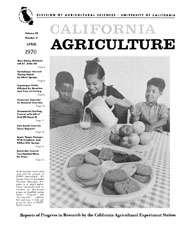Calag Archive
Calag Archive

Cover:
Good nutrition means good food and the purpose of ENEP - Agricultural Extension Service’s Expanded Nutrition Education Program - is to attack malnutrition nationwide with instruction for low-income groups on healthful eating habits. “Taste-ins” and “mini-gardens” help put across the story of ENEP-Youth program.
April 1970
Volume 24, Number 4
Volume 24, Number 4


